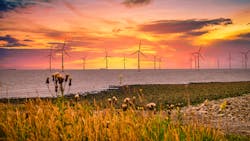‘Global stilling’ poses challenge to offshore wind market
Editor's note: This Offshore Wind Energy column first appeared in the January-February issue of Offshore magazine. Click here to view the full issue.
By Bruce Beaubouef, Houston
While high hopes for the offshore wind market continue to mount, the phenomenon of “global terrestrial stilling” may prove to be a significant reality check on those hopes. The effects of this phenomenon can be seen in recent “wind droughts” that have impacted Europe and the UK in recent months and years.
This past December, the UK and much of western Europe found itself in the middle of one such wind drought. For several days, the winds offshore Europe and Great Britain were “calm, with barely a breeze,” according to one report. The impact on spot power prices was dramatic. On December 11, the wholesale cost of electricity hit new record highs in the UK market, driven by the loss of offshore wind capacity and high natural gas prices.
The result was that, in the UK at least, utilization of fossil fuel-based power had to be increased significantly. For comparison, for most of last year, offshore wind energy produced 28% of the UK’s electricity, a not insubstantial sum. During that time, natural gas accounted for 42% of the power produced and coal accounted for 1.6% of the supply.
But with the advent of December’s wind drought, gas-fueled power plants had to be ramped up to provide for 61% of the UK’s electricity supply, and use of coal was increased to 3.6%, more than doubling what it had been. Wind power, by contrast, had fallen to 3.4% – even less than the amount generated by coal, in that timeframe. It wasn’t until the latter part of the month that wind speeds began to pick back up. While the event may have been deemed unusual, it did show the limitations of renewable energy in some weather conditions.
However, the December wind drought was not without precedent. Much of Europe experienced episodes of global stilling in 2021, from the summer into the fall. Wind speeds in many places slowed to about 15% below the annual average, and in other places, the drop was even more pronounced. It was one of the least windy periods in the UK in the past 60 years, and the effects on power generation were dramatic. Wind farms produced 18% of the UK’s power in September 2020, but in September 2021, that percentage plummeted to only 2%. To make up the energy gap, the UK was forced to restart two mothballed coal plants.
Scientists say that global stilling is caused by the rapid warming of the Arctic, which in turn narrows the temperature difference with the tropics, a gap that drives wind generation. And some researchers have found that global stilling has been ongoing for decades. From 1978 until 2010, research showed a worldwide stilling of winds, with speeds dropping 2.3% per decade. But the record has been mixed. In 2019, a group of researchers found that after 2010, global average wind speeds had actually increased – from 7 miles per hour to 7.4 miles per hour.
Scientists working for the United Nations’ intergovernmental panel on climate change have looked at what could happen to wind speeds in the future. Even if the global energy marketplace reaches “net zero” in 2050, winds are still expected to weaken significantly in the northern hemisphere. In the UK, the average wind speed is expected to drop by 2% to 3% by 2050, and 10% by the end of the century.
According to a recent study in Nature, the Arctic has, since 1979, been warming four times faster than the rest of the world. That’s much quicker than scientists had previously thought, and this warming could presage an even steeper decline in wind than anticipated.
These projections are hugely important because the UK and much of Europe are betting big on offshore wind. The UK currently has 14.2 GW of onshore wind turbines, with another 13.7 GW offshore. The government wants to increase offshore capacity to 50 GW by 2030, and to turn off gas and coal power stations by 2035.
But as the wind droughts show, merely having the turbines manufactured, fabricated and installed offshore does not make them generate energy. As has been noted before, for the offshore wind industry to be relied upon as a significant and reliable source of power generation, there will need to be some important ancillary technologies brought to the fore. These include large-scale batteries for storing energy when there is sufficient wind, and other complementary technologies such as floating solar power arrays.
